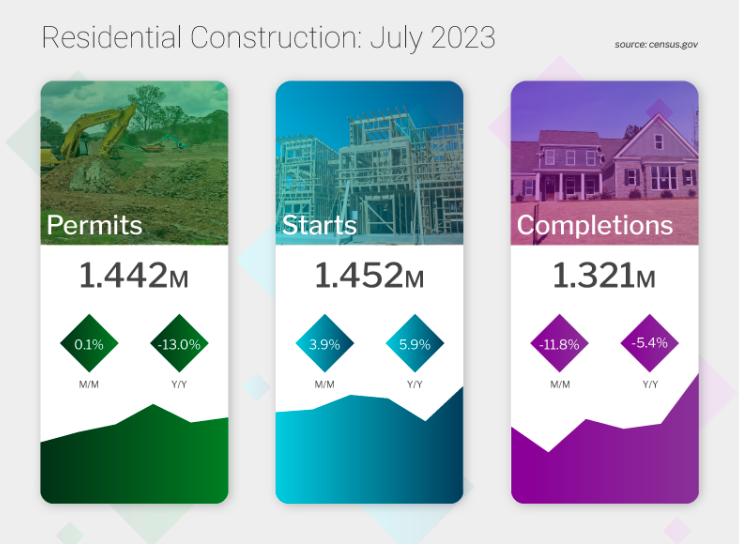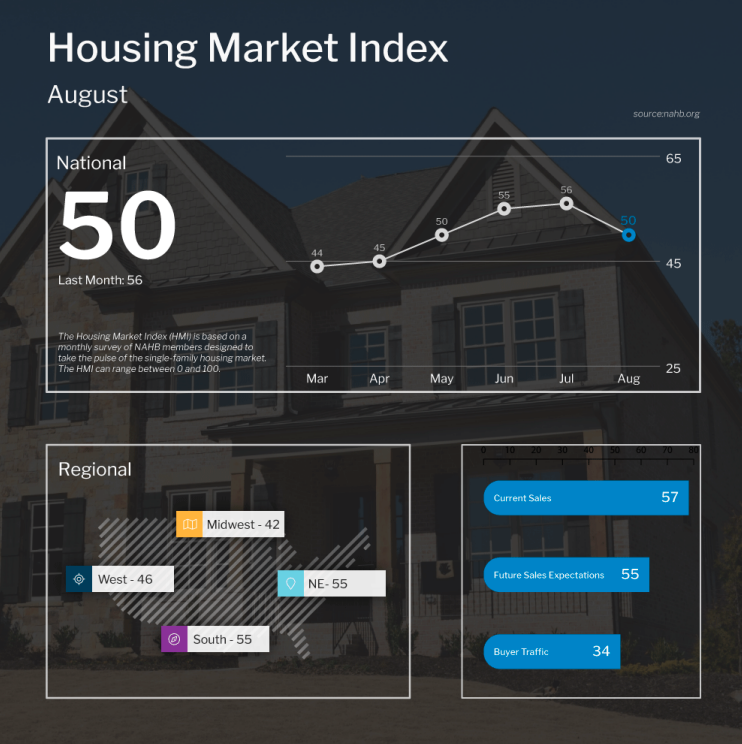Despite ongoing challenges facing home builders, construction activity picked up last month. Plus, the minutes from the Fed’s July meeting provided some hints about what’s next for rate hikes. Here are the latest headlines:
- Strong Summer for Housing Starts
- Understanding the Decline in Home Builder Confidence
- Are More Fed Rate Hikes Ahead?
- Initial Jobless Claims Remain Tame
- What an Important Recession Indicator Is Saying
Strong Summer for Housing Starts

Home construction picked up in July as Housing Starts, which measure the start of construction on homes, were up 3.9% from June. Starts for single-family homes also saw improvement, as they were 6.7% higher from June to July. Building Permits, which are indicative of future supply, were relatively flat last month. Permits for single-family homes rose 0.6% from June to the highest level in a year.
What’s the bottom line? The last three months have brought the highest number of Housing Starts so far this year. While this is a step in the right direction, more inventory is needed to meet demand.
When we look at new supply that will be coming to market (around 1.45 million homes annualized per the latest Housing Starts total) and subtract roughly 100,000 homes that need to be replaced every year due to aging, we’re well below demand as measured by household formations that are trending at 2.07 million. Even looking at future supply (Building Permits at 1.44 million annualized), we’re still lower than where we need to be.
This ongoing disparity between supply and demand is a key reason why home values continue to rise and why now provides great opportunities to take advantage of appreciation gains.
Understanding the Decline in Home Builder Confidence

The National Association of Home Builders (NAHB) Housing Market Index, which measures builder confidence, fell six points to 50 in August. However, this latest reading follows seven consecutive monthly increases and confidence remains right at the breakeven level between expansion and contraction.
What’s the bottom line? The NAHB cited several reasons for the decline in sentiment this month, including rising mortgage rates, high construction costs stemming from a lack of workers, a shortage of buildable lots, and ongoing shortages of distribution transformers (which are crucial for converting voltage in transformer lines to appropriate household levels). Record high heat may have also deterred some potential buyers from home shopping, thereby impacting builders’ perception of buyer traffic.
Are More Fed Rate Hikes Ahead?
The minutes from the Fed’s July meeting showed that the Fed no longer believes that our economy will enter a recession, but they do see downside risks to growth. The Fed also believes there are upside risks to inflation, as the minutes showed they are not yet sure they have won the battle on inflation and more rate hikes may be ahead.
What’s the bottom line? Remember, the Fed has been hiking its benchmark Fed Funds Rate (which is the overnight borrowing rate for banks) to try to slow the economy and curb inflation. July’s hike of 25 basis points was their eleventh since March of last year.
All eyes are now turned to September 20, which is when the Fed’s next rate decision will be announced. Inflation, labor sector and other economic data released in the coming weeks will play a key role in this decision. The minutes did show that the Fed feels the labor market needs a “balancing of demand and supply.” In other words, they may want to see weaker headline job figures before calling it quits on rate hikes.
Initial Jobless Claims Remain Tame

One area of the labor sector still not showing sustained weakness is unemployment claims. The number of first-time filers fell by 11,000, with 239,000 Initial Jobless Claims reported in the latest week. Initial Claims have remained relatively tame after topping 260,000 for the first three weeks of June. which suggests that employers are trying to retain their workers. This trend coincides with recent reporting that many businesses are struggling to find qualified workers for their positions.
Meanwhile, Continuing Claims rose by 32,000, with 1.716 million people still receiving benefits after filing their initial claim. This number has been trending lower since topping 1.861 million in early April, reflecting a mix of people finding new jobs and benefits expiring.
What’s the bottom line? With the Fed focused on employment data, this was an important real-time report because it includes the sample week that the Bureau of Labor Statistics will use in the modeling for their job growth estimates. Again, the Fed will be closely analyzing this headline job growth figure when August’s Jobs Report is released on September 1.
What an Important Recession Indicator Is Saying
The Conference Board reported that Leading Economic Indicators (LEI) fell 0.4% in July, which is the sixteenth consecutive month of declines. The LEI tracks where the economy is heading, and it “continues to suggest that economic activity is likely to decelerate and descend into mild contraction in the months ahead,” explained Justyna Zabinska-La Monica, Senior Manager, Business Cycle Indicators.
What’s the bottom line? Despite the Fed’s belief that we can avoid a recession, the Conference Board is standing by their forecast that our economy will enter “a short and shallow recession in the Q4 2023 to Q1 2024 timespan.” Yield curve inversions, near record high credit card debt, and the lag effect of the Fed’s rate hikes are additional reasons why a recession may not be off the table just yet.
While a recession is not a great thing for the economy, one positive aspect is that periods of recession are always coupled with lower interest rates.
Family Hack of the Week
This Melon Mint Agua Fresca courtesy of the Food Network is delicious, easy to make, and perfect for beating the heat all summer long.
In a blender, add 4 cups peeled and seeded cantaloupe or honeydew, 4 cups cold water, 1/4 cup honey, 1/2 cup chopped fresh mint, and the juice and zest of 2 limes. Blend until smooth, adding more water if needed. Strain through a mesh sieve into a pitcher; discard the solids. Add more sweetener if desired.
Serve over ice, garnish with fresh mint and enjoy. This recipe can also work with other ripe fruits such as peaches, nectarines, mango, pineapple and berries.
What to Look for This Week
More housing data is ahead, as July’s Existing and New Home Sales will be reported on Tuesday and Wednesday, respectively. Look for the latest Jobless Claims figures as usual on Thursday.
Investors will also be watching closely as economists, central bankers and policy makers from around the world join the Fed for its Jackson Hole Economic Symposium, which starts on Thursday.
Technical Picture
Mortgage Bonds ended last week trading in a range with support at 97.563 and resistance at 97.984. The 10-year remains below the 4.33% ceiling, which is the high from October and a very important technical level. Yields ended last week around 4.25% and are also overdue for some relief.

